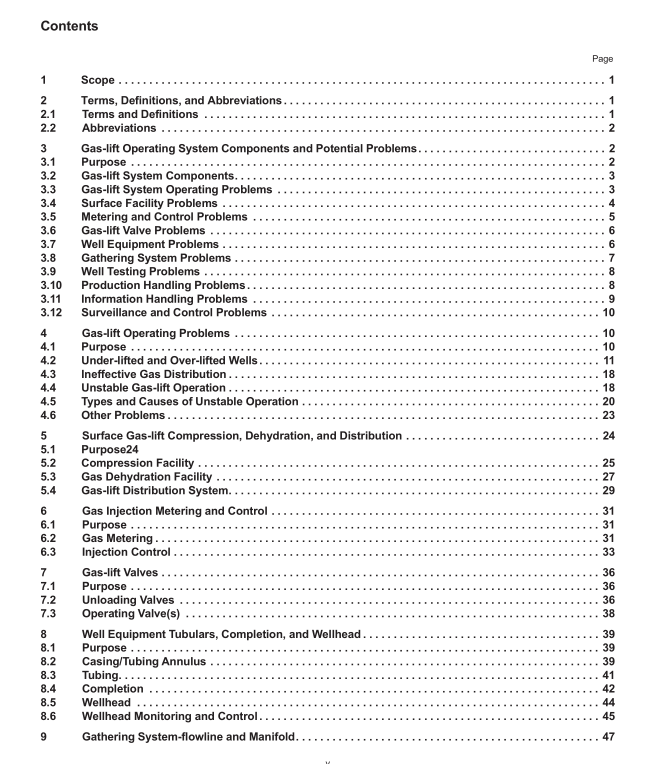API RP 19G5 pdf download

API RP 19G5 pdf download Operation, Maintenance, Surveillance, and Troubleshooting of Gas-lift Installations
b) Gas injection control problems (see 6.2).
-Operate close to the design conditions of the gas-lift installation.
Redesign and re-install the gas-lift valves if the well conditions have changed enough to disturb effectiveoperation.
-Use a properly ranged gas flow controller to provide consistent,stable flow.3.6Gas-lift Valve Problems
Typical problems with the unloading and operating gas-ift valves and recommended practices that should beperformed are as follows.
a) Unloading valve problems (see 7.2)-
– Check the gas-lift performance of each well to detect heading or valve operating problems.
Size the unloading valves to provide for enough gas passage to facilitate transfer to the deeper valves duringkickoff and unloading or, use downstream chokes in lPO unloading valves to minimize throttling, avoid over-injection, and minimize damage to the valve port and seat during the unloading process.
Follow the unloading procedures in Section 12 to work down to the desired operating valve and avoid valvedamage during unloading operations.
b) Operating valve problems (see 7.3).
Use an orifice rather than a gas-lift valve in high productivity index (Pl) wells[more than 0.5 B(DIpsi (0.012m3/D/kPa)] to prevent throttling and permit a wider range of gas injection rates.
Use an lPO gas-ift valve in low Pl wells to prevent over-injection and low casing gas pressure, which causeshydrate formation at chokes or excessive gas withdrawal from the distribution pipeline; use of a PPO valve inthis case is not recommended.
-Use a choke downstream of the orifice to protect the orifice and avoid over-injection.
Resize and re-install the operating valvelorifice if well conditions change enough to disturb effectiveoperation.
3.7Well Equipment Problems
Typical problems with gas-ift well equipment such as tubulars,completion equipment,and wellheads andrecommended practices include the following.
a) TubinglCasing annulus problems (see 8.2).
-Use a casing scraper during workovers to clean debris from the casing wall.-Circulate fluid to ensure that the annulus is clean.
—Hydrostatically test to gas-lift injection pressure to verify casing integrity.
Avoid attempting to lift two well completions in one casing annulus. lf possible, avoid dual gas -lift. if dual gas-lift is required, refer to APl 19G9.
b) Tubing problems(see 8.3).
-Circulate fuid to clean the tubing of corrosion products,scale depositions,and paraffin. If tubing has
excessive deposits,pull and replace it with a clean string
Remove any unnecessary obstructions, such as scale or paraffin or an unnecessary safety valve if one is notneeded if the well can’t sustain flow to the surface.
Use a mechanical set permanent or retrievable packer that holds in both directions.
Use an on-off tool with a profile nipple that permits an X-plug with equalizing prong or another type of landingnipple with a different profile (such as R, RPT, DB, etc.) to be set in the profile. The plug can be set when thetubing and valves are removed to eliminate kill fluid damage to the reservoir formation.
c) Completion problems (see 8.4).
Run flowing bottomhole pressure (FBHP) and static bottomhole pressure (SBHP) surveys at least annuallyto assess and track well performance and reservoir productivity.
Stimulate a well if its productivity becomes impaired and a pressure buildup test indicates that skin can bethe problem.
Minimize pressure surges and heading in a well that has sand producing reservoir rock or a sand controlscreen or gravel pack.
d) Wellhead problems (see 8.5).
—Minimize flow restrictions such as bends, choke bodies, etc.-Provide safe and easy access for wireline work.
e) Wellhead monitoring and control problems (see 8.6).
Measure the wellhead production pressure on a consistent basis.
Consider continuous measurement of the well’s production rate using multiphase metering or productionflow rate estimating technology.
3.8Gathering System Problems
Typical problems with gathering system equipment, including the flowlines and manifold, and recommended practicesthat should be performed are as follows.
a)Flowline problems (see 9.2).
—Keep the flowline clean and avoid restrictions.
– Use appropriate treatments if needed to remove scale deposits,paraffin, etc.
Avoid using one flowine for more than one well;, this is to minimize excessive backpressure and avoidcomplications in monitoring the production of each well.









